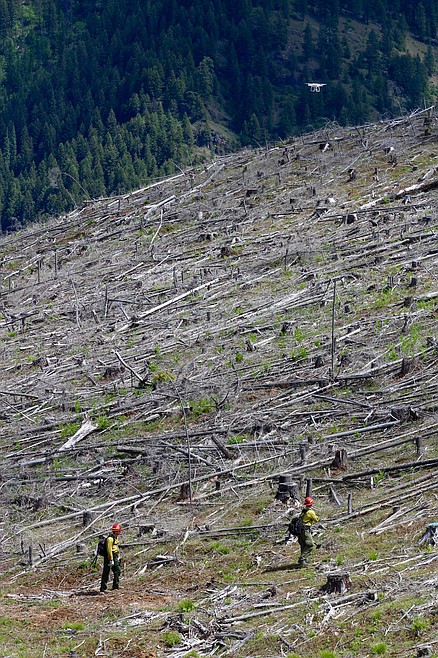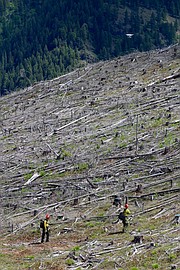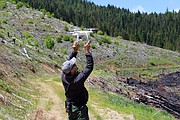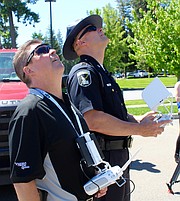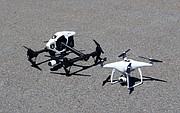They are here to help!
Drones.
That word certainly has a negative connotation, doesn’t it?
Between the news reporting on military operations overseas and Hollywood making movies involving aerial unmanned killing machines, Americans have had reason to be weary of the increasing use of drones.
The reality of their actual use on a local scale though is much less ‘explosive’ and not at all nefarious.
In fact, drones that are more akin to toy helicopters than military aircraft are being employed right now in North Idaho to keep residents and officials safe.
That is the message that state agencies such as the Idaho Department of Lands (IDL) and the Idaho State Police (ISP) are attempting to convey to the public.
“Our goal is to get it accepted by the public,” ISP Capt. John Ganske said at a recent drone demonstration at ISP’s region one office in Coeur d’Alene.
Capt. Ganske and Lt. Alan Oswald, both FAA certified Unmanned Aerial Vehicle (UAV) operators, showed off two of the six drones that ISP owns statewide.
The DJI Phantom 4 and Inspire 1 quadcopters that were used in the demonstration have several features such as self-stabilization (auto-correcting for wind), camera interchangeability, and subject tracking that have the potential to greatly assist troopers in a variety of situations.
Ganske explains that so far, these drones have been “primarily used for documenting crime scenes.”
For example, Ganske had recently used the Phantom 4 to document the scene of a car wreck in Post Falls by flying the drone high above the area and taking a picture.
This bird’s eye view of a scene can invaluable to determining how the wreck occurred and documenting the surroundings.
“This (the use of drones) will take some of the guess work out of it,” Lt. Oswald said.
Ganske says that the full benefits of using drones in a law enforcement environment are still being discovered, but ISP has already found several in the limited time they have been using them in the state.
Live video streaming of a crime scene or hazardous area, search and rescue, suspect location and tracking, navigational guidance, and surveillance are all practical uses with this new technology.
Here in Shoshone County, Ganske says that the use of drones in an area such as ours may have a greater use than urban areas.
“The more the rural, the more the use.”
Kjell Truesdell, Idaho Department of Lands (IDL) Fire Warden stationed in Cataldo, has been leading the charge for the use of sUAS’s (Small Unmanned Aerial Systems) in IDL operations since they saw their contracted use in the 2015 fire season.
“Once we saw how helpful they were and their potential,” Truesdell said, “it was something we had to utilize.”
Used primarily for fire suppression efforts and forest land management, IDL has been using these drones for over two months.
In a drone simulation that IDL put on for the Shoshone News-Press and local fire officials earlier this month, Truesdell and his crew demonstrated how useful just one drone can be in a wildfire situation.
FAA certified drone operators Jim and Chris Myers guided a three man wildfire crew through a wooded area south of Pinehurst with the use of a DJI Phantom 4 looking for simulated spot fires (tree stumps marked with blue paint).
Like the ISP Troopers, the IDL operators started using drones as a hobby.
Streamed directly to a flat screen TV setup in the command post, the operator/spotter duo was able to effectively identify all problem areas with the sUAS’s on-board camera, relay those locations to the ground crews, then guide them to those spots for fire suppression.
The sUAS also have the ability to mark the areas for future reference, track the fire crew progress, and give the command center a complete picture of the operating area.
Simply put by Chris during the exercise, the drones are “cheap, effective, and efficient.”
Doing a job that normally only could be completed by the use of a helicopter, the sUAS can be deployed in a matter of minutes to help fire crews and can be available to scout even the smallest fires where traditional air resources are typically not available.
In addition to being low risk and more available than other methods, using sUAS’s for tasks like reconnaissance is very cost effective.
“It basically pays for itself the first time you use it,” Truesdell said.
The IDL crew explained the cost of a UAS platform is around $1500 and can be used over and over, as long as the batteries are charged.
Truesdell stresses that “fire operations will always need manned aircraft” for water delivery, crew insertion and other purposes, but the sUAS’s are invaluable tools that can increase the safety and efficiency of firefighters right now.
“They are a supplemental tool for the tool box.”
With the use of drones for official purposes on the rise, both ISP and IDL want to stress that they are not being abused.
Ganske says that ISP is understanding of privacy issues concerning drones and assures everyone that they “would never violate privacy expectations.”
In any situation were ISP would fly a drone close to any residence, Ganske says that a warrant must be obtained first.
Truesdell echoed Ganske’s point that the drones used by him and his crew will not be used to violate anyones privacy.
“We’re not doing anything malicious, we want to supplement our folks and use this as a tool.”
To those who are still weary of drones for fire suppression/ land management in our area, Truesdell says he wants to hear the issues you may have.
“I would definitely like to understand what their concerns are,” he explains,“our focus is typically away from communities and is in the woods.”
He adds that, “there are fires that we work collaboratively on with local fire departments near urban areas, and the situational awareness (gained by the use of sUAS’s) of what the fire is doing can potentially save acres burned and threatened structures.”
During an event like this, IDl asks that recreational drone users stay clear of fire operations as it can directly impede suppression efforts.
For those with questions about drone use by our local state agencies, contact ISP Public Information Officer, Tim Marsano at 208-884-7122.
For IDL, contact Kjell Truesdell at the local Cataldo office at 208-682-4611.


